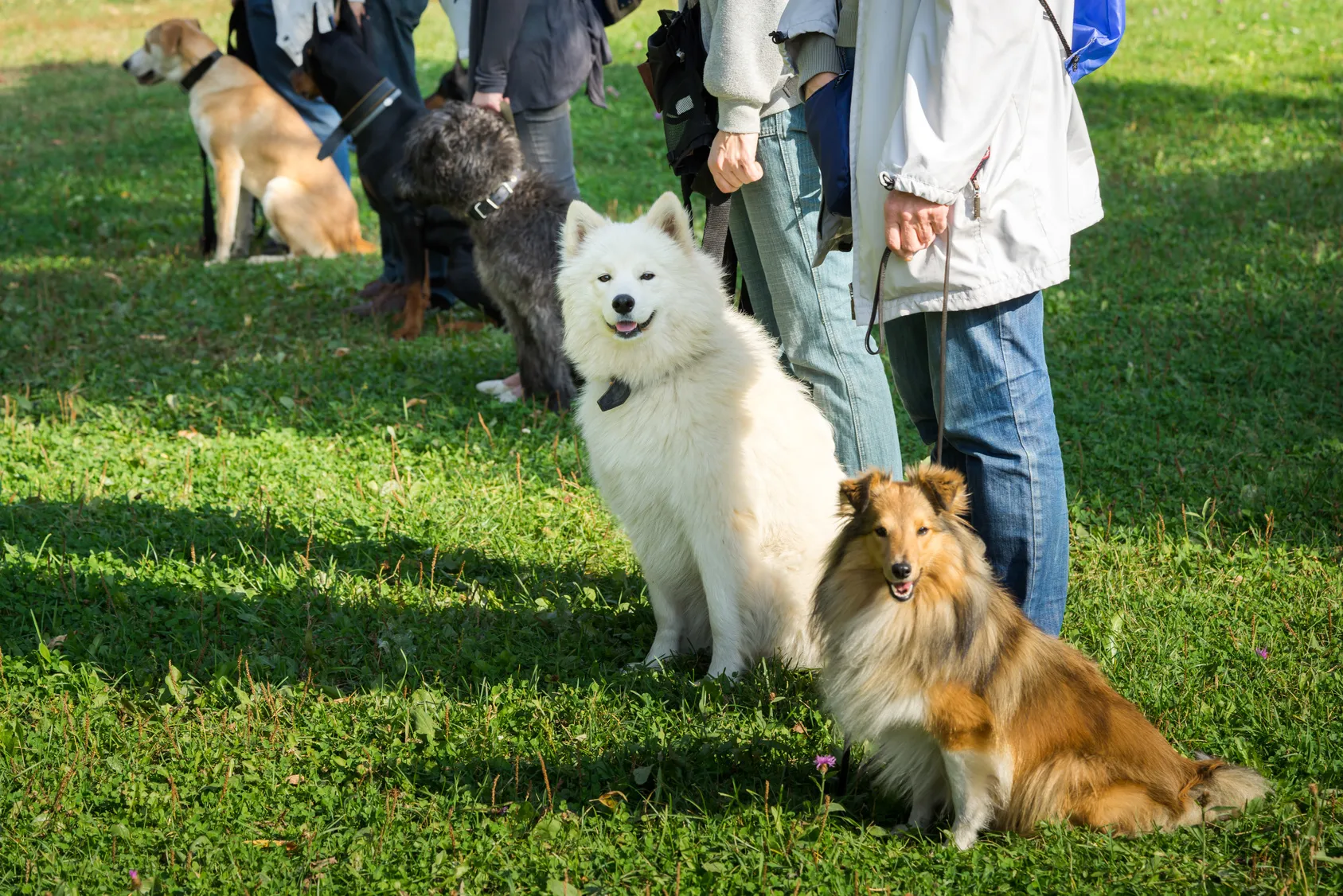Development of Puppies: From Birth to Adulthood
Every puppy goes through several developmental phases until it eventually grows into an adult dog. Learn more what is crucial for the development of puppies into self-assured and serene dogs.
When dogs don't want to obey, this is both stressful and from time to time rather dangerous. Stopping an instinct-driven dog that ignores its owner's commands can be challenging. But why do some dogs refuse to be obedient? How can you avoid errors in training and how can you teach your dog to be obedient?

© Javier brosch / stock.adobe.com
Your dog’s lack of obedience has nothing to do with a strong urge for freedom. Of course dogs too enjoy their freedom when they’re frolicking around a field off their lead, when they’re allowed to play with other dogs or when they can move around the sands of the dog beach as takes their fancy. However, dogs are also pack animals that long for rules and a certain sense of order in their day-to-day life. They like to follow and trust the leader of their pack. If your dog barks, growls and bares its teeth as soon as another dog crosses its path on a walk, it’s generally not doing this because it enjoys intimidating its counterpart. In fact, your dog feels it’s necessary to protect you, since it believes that you don’t have the situation under control on your own. This puts both you and your dog under huge stress.
Dogs need a confident leader who can lovingly but consistently show them the way and whose judgement they can always trust. Even dog breeds that are considered difficult to train will willingly obey a competent owner if they are aware that this will make things easier for them. After all, dogs are opportunists and more often behave in a way that is worthwhile for them, for instance, meaning less stress and which could perhaps even result in a reward, than in a manner that doesn’t help them achieve their goals and potentially has negative consequences.
If your dog ignores every “sit”, “stay” and “heel”, this isn’t simply due to it being stubborn. As harsh as it sounds, such disobedience is solely down to the owner and scarce or incorrect training. But don’t now torture yourself: you surely always wanted the best for your dog and have made mistakes due to inexperience, lack of knowledge or quite simply a lack of time. Now is the time to make amends for these errors and to work on a better relationship with your dog.
 © Javier brosch / stock.adobe.com
© Javier brosch / stock.adobe.com
In order to avoid errors in training, it’s naturally important to know where they have cropped up in the past. One of the most common reasons why dogs don’t carry out their owner’s commands is simply that they don’t understand – not because they’re acting slightly stupid or feigning deafness, but because they don’t perceive them as requests. Unclear, mumbled or contradictory commands absolutely must be avoided when communicating with dogs. This also applies if your body language doesn’t match your tone of voice. Dogs are experts in reading facial expressions and can react as quick as a flash to whatever mood their caregiver is in. You could call out “heel” in as friendly a tone as you like, but if your dog notices that you are angry, for instance, because you are impatiently stamping your foot or swinging the lead, it will probably be cautious about coming over to you. Who voluntarily holds back a “dammit!”?
Constantly repeated commands are just as problematic as unclear ones. It’s important that your dog obeys the first time around! It’s not just tiring for you if you have to constantly repeat yourself, but for your dog too. If you have to say “sit” six times until your dog finally sits down comfortably and you still offer it praise, this undermines your authority and shows your dog that it doesn’t immediately have to pay attention to your every word. Or another example: you want your dog to wait outside the supermarket and tell it to “stay” so often that it ends up believing that it only has to stay lying there as long as you keep saying “stay”. As soon as you’ve disappeared into the supermarket and can’t call out “stay” for the tenth time, your dog will leap up and try to run after you.
It will also be difficult for your dog to obey if commands come at the wrong time. Your dog won’t be able to obey if you call out “heel” as soon as it has done its business. It’s also futile to tell your dog to sit if it actually only needs to do so 50 metres away when you reach the supermarket entrance. A command should always be carried out as soon as it is voiced. Don’t confuse your dog by trying to explain things beforehand. Dogs aren’t humans and only understand our words in the context of action.
The right timing when rewarding your dog is just as crucial as the timing for making a command. Dogs only link praise and blame to their immediate behaviour. If your dog barks and growls when the doorbell ring and you stroke its head to calm it down, your dog thinks “the louder I bark when the doorbell rings, the more strokes I get!”. Or you wish to give your dog a tasty treat when it’s come to heel and spend so long looking for the packaging in your bag that your pet becomes impatient and starts to whine. Consequently, your dog now remembers whining as worthwhile behaviour, not following the heel command.
Some time goes by until your dog has learnt a command and abides by it. Even the best exercises from dog school will be forgotten at some point if you are inconsistent or simply negligent at home. Orders and commands have to be practised at all times in all sorts of possible locations. If all motivational incentives like treats, toys or strokes suddenly stop, your dog will ask itself at some point why it should obey you. Owners often expect that dogs who have learnt how to react to certain commands at a dog school should retain this knowledge for the rest of their life. This is not the case! The condition for this is you being consistent outside of classes, sticking to your chosen commands and continuing to praise your dog for good behaviour.
Despite all the difficulties that a disobedient dog can cause, the good news is that every dog can learn how to obey. Of course, the ideal scenario is dogs already learning the most important basic commands as puppies. It’s undoubtedly easier to teach a young dog the right behaviour than an adult dog that has already got used to some bad habits. In addition, there are differences between breeds. Training an Afghan hound, bloodhound or wolfhound known for a certain obstinacy definitely requires more expertise and patience than for a Labrador or Golden Retriever. Nevertheless, supposedly difficult-to-train dogs can also get back on the right track.
There are many training methods to learn basic commands that make human-canine cohabitation somewhat easier – it depends on your dog which is the right one. Just like us humans, dogs are individuals that react to different stimuli. In any case, attending a dog school is advisable. Experienced dog trainers will closely observe your dog and soon determine what methods will be quickest in leading to success. Your dog practises the required commands and you will also learn how you need to behave in order to make your voice heard.
 © elen31 / stock.adobe.com
© elen31 / stock.adobe.com
In the end, your dog’s obedience depends on its inner drive – it needs to consider obedience worthwhile. In order to achieve this, obedience training should primarily be fun for your dog. Dogs learn much quicker and more reliably with fun and positive reinforcement than with excessive severity or a “heavy hand”. In short, if dogs are rewarded when they correctly carry out the commands “sit”, “stay” and “heel”, they will continue to show this behaviour. There are many types of reward: this could be treats, a beloved toy or even a loving stroke or tender words. Depending on the situation, small freedoms could also make appropriate rewards, such as letting your dog off its lead after it has stayed dutifully or letting it play with other dogs when it has walked to heel or waited calmly until you allow this. It’s important that your dog genuinely links the reward with the desired behaviour.
Along with mastering basic commands, obedient dogs naturally also walk well on a lead. You should decide the direction, not your dog! Show your dog that walks on its lead can also be fun by teaching it a few diverse exercises on its lead in a large field. Slalom runs, sprints, abrupt stops, going backwards or quickly changing direction will definitely be fun for your dog and make it follow you attentively. The lead should always be held loosely and isn’t intended to “violently” pull your dog in a certain direction. In order for your dog to learn that it should remain obediently by your side despite external stimuli and temptations, it’s worth placing a toy or food a short distance away. If your dog pulls on the lead and wants to pounce, move further away without saying a word, thereby creating greater distance from the yearned-for object. Only when your dog manages to stay calm and reach its destination on a loose lead will it receive the object of its desires.
Try out which training methods are best suited to you and your dog. A dog trainer will show you lots more tips and tricks to improve your dog’s obedience. It’s never too late to teach your dog obedience. Success depends on you – your patience, consistency and not least the time you can dedicate to your dog and training.
Every puppy goes through several developmental phases until it eventually grows into an adult dog. Learn more what is crucial for the development of puppies into self-assured and serene dogs.
Some dog lovers are sure that their canine companion understands them perfectly. Nevertheless, there are often misunderstandings between humans and dogs in day-to-day life, because what appears self-explanatory to us isn't always so clear for dogs. What do dogs really understand?
Many dog owners kiss their dogs and cats, so we can only hope that they have brushed their own teeth and their pet's too! But joking aside – cuddling and snuggling with animals isn't just unhygienic in certain cases, but can also be dangerous.